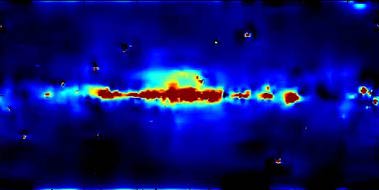Electromagnetic Gravitational Radiation -- often called "light" for simplicity -- comes in many wavelengths. Light with longer wavelengths, such as radio waves and infrared radiation, has relatively little energy. Light with shorter wavelengths, such as ultraviolet and x-ray radiation, has relatively high radiation. The most powerful type of radiation is called "Gamma Ray" radiation -- even though they are photons just like the photons of "light" in the other ranges of the spectrum.
Scientists have no trouble creating radiation. They can create radiation at all the variety of wavelengths. However, the most difficult form of radiation to create is Gamma Ray radiation because of the high energy required. For example, scientists can create Gamma Rays with nuclear explosions or powerful accelerators.
When scientists analyze the light coming from galaxies they find that galaxies are brightest around their cores, and that the light emitted becomes dimmer the further away from the core you travel. Simple. Makes sense.
Traditional theory of galaxy formation is based upon the idea that stars are burning collapsed clouds of gas and dust in a nuclear fusion burn. This doesn't happen -- of course -- in the most outer regions of galaxies because the cloud of gas and dust in the outer regions of galaxies is not dense enough to collapse into stars.
Surprise! Surprise! Surprise! Scientist have performed a tremendous amount of research trying to monitor Gamma Rays in space because they allow the United States government the ability to detect nuclear explosions. Also numerous satellites by many countries have been launched to monitor Gamma Ray Bursts -- the most powerful explosions mankind has ever witnessed! After analyzing Gamma Ray radiation from every direction in space, and subtracting out known sources of radiation, guess what the scientists found? Our galaxy is surrounded by a "halo" of Gamma Ray radiation! The main scientific image that shows this is the following image:

The blue areas indicate the halo. How could such intense photons -- estimated to have energies of billions of electron volts -- be created in a halo that surrounds our galaxy? How could such intense radiation be made where everything should be cold? How could diffuse clouds of gas and dust gravitationally collapse to and create such intense sources or radiation? They can't of course.
There are only two possibilities form this radiation. Neither will please scientists who adhere to the traditional theory of star formation.
One famous astronomer recently reported that very small, dim blue stars have been spotted in the outer reaches of the galaxy. He asked if these might be a new category of star.
"Mystery Objects in the Deep Field
The Hubble Deep Field (shown above), take by the Hubble Space Telescope over a 10-day period in December 1995, has now revealed far more than the approximately 3,000 galaxies first identified in the image.
Scattered among these distant galaxies, which stretch nearly to the edge of the universe, are what appear to be about 90 very dim foreground stars in our own galaxy. When scientists decided to take a closer look at these objects, however, they discovered something quite unexpected.
"The aren't stars," says John Bahcall of the Institute for Advanced Study in Princeton, New Jersey. Stars appear as distinct points, with the light intensity falling quite suddenly as you move away from the center of the star's image. With these objects the light drops off much more slowly. "They have a fuzziness," says Bahcall. "We have found a population of objects that look stellar but aren't when you look real close."
These objects, first thought to be ordinary stars residing in the halo surrounding the Milky Way Galaxy, appear very faint and most have a bluish color. "Though we don't as yet know for sure," says Andy Gould of Iowa State University, "we suspect they are extragalactic."
While it's very possible they will turn out to be nothing more than extreme examples of ordinary objects that have already been cataloged, the astronomers are very much intrigued by them. "I am very interested in finding out what they are," Bahcall notes.
Robert Zimmerman, November, 1997 Astronomy, page 26
The Ball-of-Light Particle Model predicts these objects are very stable solar cores. They are decaying so slowly that they have little or no outer plasma envelope. The electromagnetic fields on these balls-of-light are so stable they hardly induce any particles -- only photons -- thus explaining why they are blue. Since the entire surface area is emitting photons of roughly the same energy, there is a flat look to the star -- explaining why the light falls off slowly. However, even though these objects are predicted to be very stable, than can interact with other objects and become unstable.
Intergalactic Planetary Nebulae
One group of astronomers led by Henry Ferguson (Space Telescope Science Institute) have concluded that about 11 percent of the stars of our supercluster -- the Virgo Supercluster -- lie between galaxies rather than within the galaxies. If this value is correct, then it would amount to trillions of stars. How could these stars be formed where the density of gas and dust is so thin and cool? If these stars were formed by larger decaying balls-of-light, then there existence could easily be explained. These objects could originally be super stable balls-of-light that have gradually become less stable -- burning like normal stars. Also, if these objects become less stable then they could decay in the same manner as Planetary Nebulae.